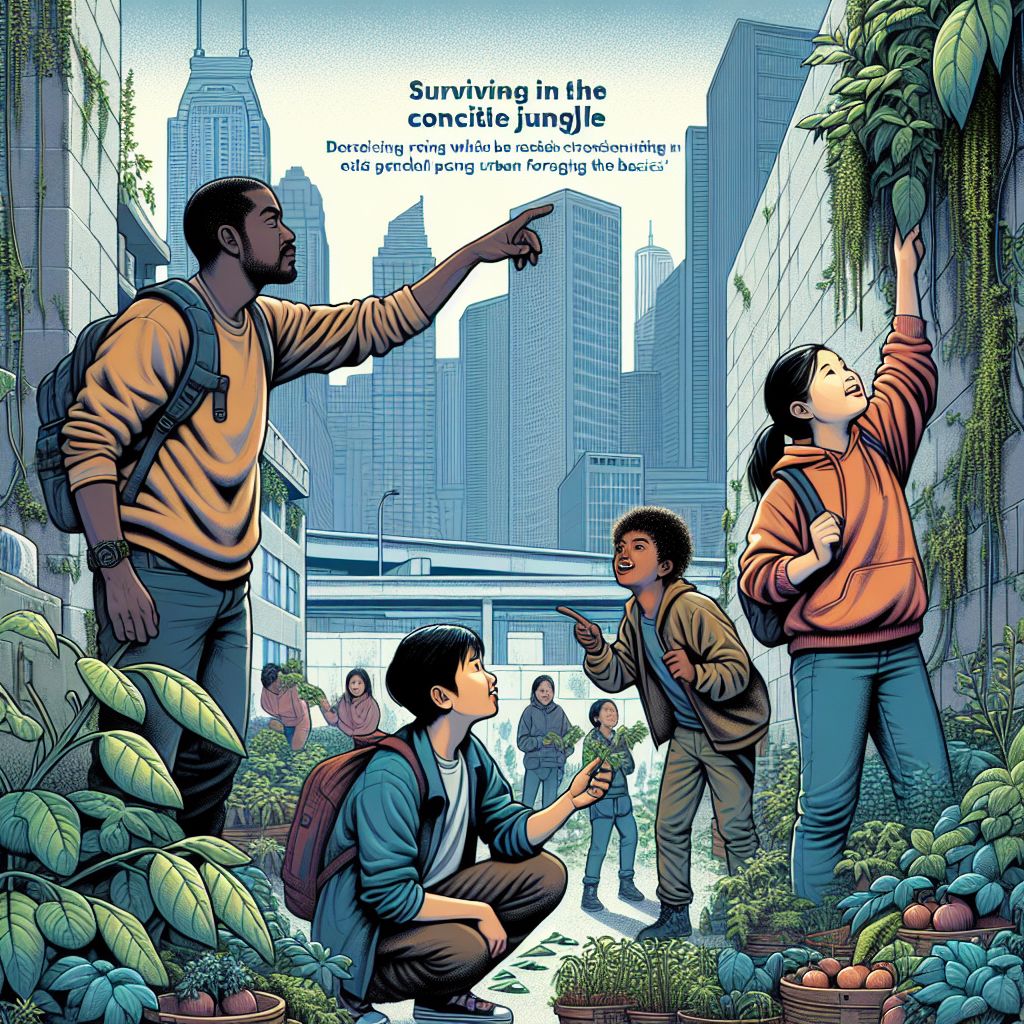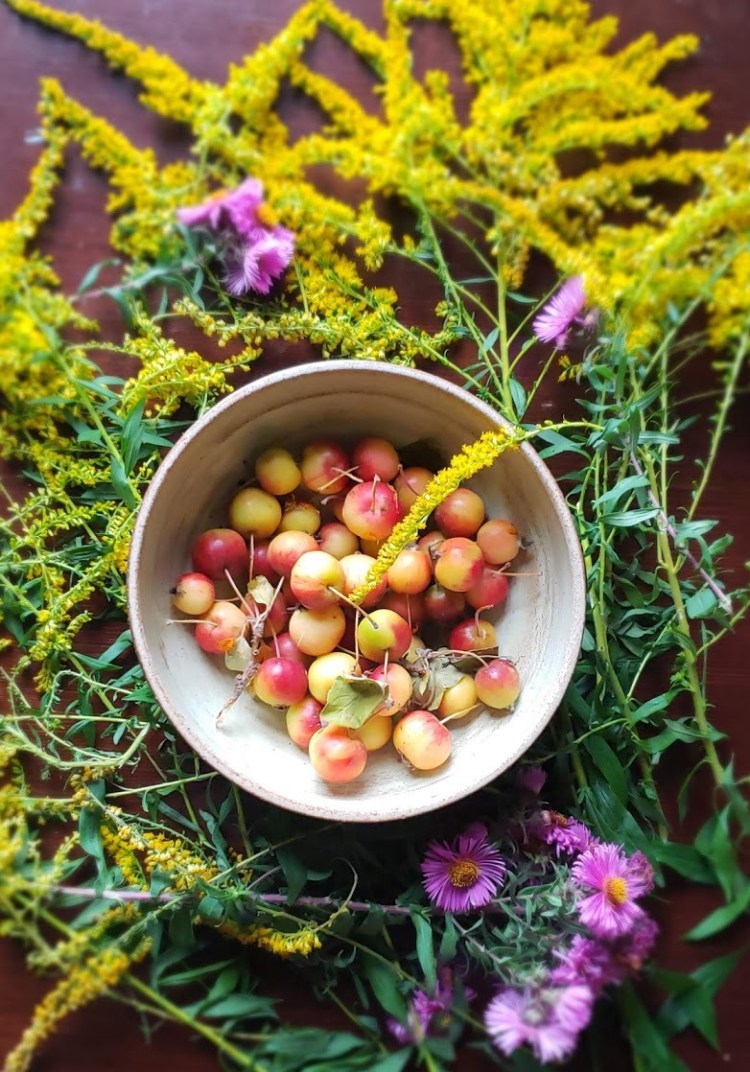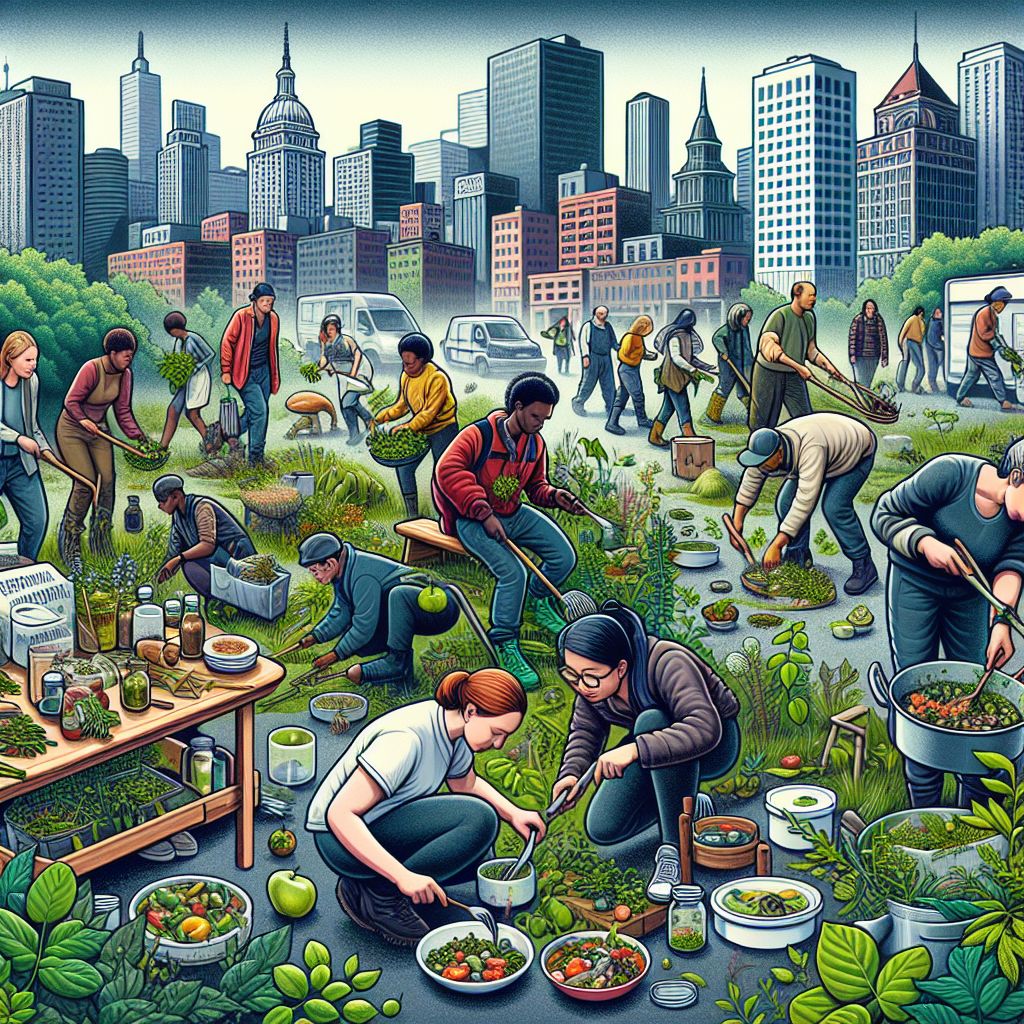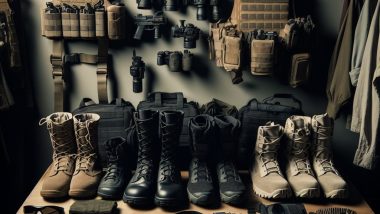Key Points of the Article
-
Finding edible plants in the city
-
Legal issues with foraging in urban environments
-
Must-have tools for city foragers
-
Choosing the right foraging bag for your needs
-
Identifying and avoiding poisonous plants and pollution in the city

Surviving in the Concrete Jungle: Urban Foraging Basics
Imagine this: you’re walking down your city streets, surrounded by concrete and steel. Now, picture finding a hidden patch of wild strawberries or a group of edible greens in an unexpected place. This is urban foraging, and it’s not just a fad—it’s a skill that can provide you with fresh, free food and a stronger connection to your surroundings. Ready to start your adventure? Let’s dive in.
Finding Edible Plants in the City
First, understand that cities are not just barren wastelands. They are teeming with hidden treasures, but you have to know what to look for. Most importantly, you need to make sure that what you’re gathering is edible. Here’s what to do:
-
Secure a comprehensive field guide that’s tailored to your specific region. Alternatively, you could download an app that aids in plant identification while you’re out and about.
-
Participate in local foraging groups or workshops to gain knowledge from seasoned foragers.
-
Always cross-reference your discoveries with multiple sources. If you’re uncertain, don’t consume it!
Keep in mind, the urban landscape is ever-changing, and the plants that flourish in it are no different. Monitor various areas as the seasons change, and you’ll be amazed at what you can discover.
Understanding the Law Before You Forage
Before you begin foraging, it’s essential to understand the laws. Foraging isn’t a free-for-all; there are rules and regulations in place to protect both foragers and the environment. Here’s what you need to know:
-
Local authorities may require permits or have restrictions for foraging in public spaces like parks—make sure to check with them.
-
Don’t forage on private property without permission—it’s not only against the law, but it’s also not being a good neighbor.
-
Be careful not to overharvest. Only take what you need and leave enough behind for others, including wildlife.
Respecting the environment and the community is of utmost importance. Foraging responsibly ensures that these urban resources stay available for everyone.

Street Survival: Must-Have Gear for Urban Foragers
Foraging in the city is about more than just knowing what to look for. You also need the right equipment. Whether you’re an experienced forager or a beginner, these must-have items will help you collect your urban harvest safely and effectively.
Essential Tools for Urban Foraging
Here’s what you need in your urban foraging kit:
-
A sturdy pair of gloves to shield your hands from thorns and contaminants.
-
A sharp knife or pair of pruning shears to cleanly cut plants.
-
A small trowel or digging tool for harvesting roots or tubers.
These tools are not only practical, but they also show respect for the plants you’re harvesting by ensuring that you don’t harm them or their environment.
Picking the Perfect Foraging Bag
So, where are you going to stash all your loot? The bag you choose can make a world of difference:
-
Choose a backpack or crossbody bag to keep your hands free for foraging.
-
Opt for a bag with multiple compartments to keep delicate items separate from heavier ones.
-
Think about getting a bag with breathable material or mesh sections to help keep plants fresh.
Functionality is important, but comfort is also crucial. You might be out for several hours, so select a bag that won’t put strain on your shoulders or back.

“Concrete Jungle | Foraging, farming …” from concrete-jungle.org and used with no modifications.
Conquering the Concrete Jungle: Foraging Safely
Foraging in the city is thrilling, but it comes with its own set of dangers. To make sure you’re safe and your finds are good, keep these tips in mind:
Know Your Poisonous Plants and How to Avoid Pollution
Just because it grows, doesn’t mean it’s good for you. Some plants are poisonous, and others may soak up pollutants from the environment. Here’s how to keep yourself safe:
-
Get to know the common poisonous plants in your region and avoid them.
-
Stay away from foraging near high-traffic roads or industrial zones where the soil and plants could be polluted.
-
Don’t forage in areas that are known to be sprayed with pesticides or herbicides.
When it comes to foraging in the city, your health is the most important thing. Be wise about where and what you forage.
Planning Your Foraging Trip
As with many things in life, timing is key. Plants go through life cycles, and knowing these cycles can make your foraging trip more fruitful:
-
Plants are often freshest and most vibrant in the early morning, before they’ve been worn down by the sun.
-
Spring and early summer are the best times to forage for greens and flowers, while late summer to fall is the prime time for fruits and seeds.
-
Be mindful of the weather. Heavy rains may cause mushrooms to appear, but they can also lead to more pollution in plants from urban runoff.
By paying attention to these patterns, you can not only increase your foraging success but also deepen your connection with the city’s natural rhythms.
As the day goes on, it’s crucial to time your foraging trip. You want to get the best possible harvest while also reducing any potential dangers. As a result, it’s a good idea to plan your urban foraging trip around these times:
When to Forage in the City
As an urban forager, the early morning hours are your best friend. This is when plants are at their freshest, before the heat of the day has a chance to wilt them. The city is also quieter during these hours, and you’re less likely to have to fight off competition for the best finds. If you’re interested in mushrooms, a morning foray after a night of rain could yield a great harvest. Just remember, no matter what time you choose to forage, always do so responsibly and sustainably.

“Community Supported Foraging …” from gathervictoria.com and used with no modifications.
Scavenging More Than Just Greens: Exploring Other City Assets
Scavenging in the city isn’t just about plants. The urban landscape offers a multitude of other resources that can be equally beneficial for the astute prepper. Let’s investigate some surprising city treasures.
Discovering Protein in the Urban Jungle: Bugs and Beyond
It may sound crazy, but bugs can be a fantastic source of protein and they’re everywhere in the city. For instance, crickets and ants are edible and can be found in many urban environments. Just make sure you’re gathering from areas that are clean and free of pesticides. And always fully cook bugs to kill any pathogens.
Using Community Resources: Public Fruit Trees and Gardens
Several cities have community gardens or public fruit trees that are open for the taking. These can be great sources of fresh produce if you know where to find them. There are websites and apps that map out these community resources, so use them. Be sure to only take what you need and leave some for others.
Master Urban Foraging: Essential Skills and Know-How
Mastering urban foraging requires both essential skills and know-how. It’s not just about knowing what to forage, but also how to forage efficiently and safely.
Collection and Preservation: Prepper Methods
After you’ve collected your city-grown food, it’s crucial to store it in a way that maintains its freshness. For leafy vegetables, wrap them in a moist cloth before putting them in the fridge. Berries should be stored in a container with a loose-fitting lid. Herbs should be kept in a sealed container with a small piece of paper towel to soak up any extra moisture.
Safe Urban Exploration
When foraging in a city, it’s important to stay aware of your surroundings. Watch out for cars, private property, and other potential dangers. Also, remember to be considerate of the homeless population, as they may also depend on these urban resources for survival.

From Forage to Feast: Urban Prepper Recipes
Now, let’s turn your foraged finds into delicious meals. With a little creativity, you can transform simple ingredients into a feast fit for any urban survivalist.
Simple Cooking Ideas for Typical City Forage
You can fry up dandelion greens with some garlic for a healthy side. Wild berries can be cooked down into a compote that’s perfect for pancakes or yogurt. Nettle leaves, once you’ve boiled the sting out of them, are a great addition to soups and pesto.
Example: Urban Scavenger’s Nettle Pesto
Blanch nettle leaves and blend with garlic, pine nuts, Parmesan cheese, and olive oil for a twist on the classic pesto. Serve with pasta or as a spread on crusty bread.
These simple recipes not only provide sustenance but also bring the joy of nature’s bounty into your urban life.
Keeping Your Foraged Foods Fresh
Keeping your foraged foods fresh is key to making them last longer. You can dry, pickle, or can them. For example, you can dry wild herbs and store them for use all year, or you can turn fruits into jams or jellies. The important thing is to process your foraged items as soon as you can to keep their nutritional value and taste.
Every Forage Needs a First Aid Kit
When you’re out in the urban wilds, safety always comes first. That’s why a well-stocked first aid kit is your best friend. You never know when you’ll get a scrape, cut, or even an allergic reaction, so you always want to be prepared.
For city-dwelling foragers, a basic first aid kit should consist of bandages, antiseptic wipes, adhesive tape, scissors, tweezers, and over-the-counter painkillers. You might also want to include a pocket guide to first aid—after all, having the right equipment is only half the battle. You also need to know how to use it.
For instance, if you accidentally cut yourself while foraging, you should first clean the wound with an antiseptic wipe, then apply some antibiotic ointment, and finally cover it with a bandage. It’s important to change the bandage daily and keep the wound clean to avoid infection.
It’s worth noting that the contents of your first aid kit may be different based on your personal needs. For example, you might need to carry certain medications or an EpiPen if you have severe allergies. Customize your kit to suit your urban foraging needs, and you can forage with peace of mind, knowing you’re ready to handle any minor injuries.
Why You Need a Fire Starter Kit in the City
Believe it or not, being able to start a fire in the city can save your life. If you ever need to send a distress signal, cook your own food, or keep warm during an unplanned night in a park, a fire starter kit is an essential part of your urban survival equipment.
Opt for a fire starter that’s dependable and user-friendly. Waterproof matches, a magnesium fire starter, or a straightforward lighter are all suitable options. Keep your fire-starting tools in a waterproof container to ensure they stay dry and are ready to use when you need them the most.

“Urban Foraging: The Ultimate in Local …” from www.fix.com and used with no modifications.
Common Questions About City Foraging
Foraging in the city might sound intimidating, but with the right information, it’s a satisfying and enlightening activity. Here are some common questions to help you begin.
What Dangers Does Urban Foraging Present?
Urban foraging, while a wonderful way to obtain fresh food, is not without its dangers. Some of the risks you might encounter include mistakenly picking poisonous plants, foraging in contaminated areas, and facing legal trouble if you forage on private property without consent. Forage responsibly and educate yourself to reduce these risks.
How Can I Tell Which Plants Are Safe to Eat?
If you’re wondering how to tell which plants are safe to eat, a great place to start is by getting a high-quality field guide or a reliable foraging app. You can also learn a lot by attending local foraging workshops or by going foraging with someone who has a lot of experience. Always make sure to check multiple sources before you eat any plants you find in the wild.
When you’re out foraging, try to find plants that are plentiful and steer clear of those that are scarce or at risk of extinction. If you’re not certain about a plant, it’s better to not disturb it. As you gain more experience, you’ll get better at spotting which city plants are safe to eat.
Keep in mind, there are many edible plants that have poisonous doppelgangers. Wild carrots are a perfect example of this, as they are safe to eat but look very similar to poison hemlock, a highly dangerous plant. It’s vital to learn the specific characteristics of each plant to ensure you’re foraging safely in the city.
For instance, wild garlic can be recognized by its unique smell and hollow leaves, while its toxic doppelganger, lily of the valley, has solid leaves and lacks the garlic smell.
Correct identification is the key to safe urban foraging, so it’s worth spending time to learn and master this skill.
Is it Possible to Forage in Urban Parks?
-
Check the foraging rules with your local parks department—some parks may permit it, while others may not.
-
Before foraging in urban parks, make sure to get any required permits or permissions.
-
When foraging, remember to follow etiquette—only take what you will use and leave no trace that you were there.
Urban parks can be great places for foraging, but it’s crucial to respect both the rules and the environment. When foraging is done responsibly, these public spaces can continue to be enjoyed by all.
What Should I Pack in My Foraging Kit?
|
Item |
Use |
|---|---|
|
Foraging bag |
To hold and safeguard your discoveries |
|
Gloves |
To shield your hands from thorns and skin-irritating plants |
|
Sharp knife or shears |
To cut plants without causing harm |
|
Field guide or app |
To identify plants and determine whether they are safe to eat |
|
Water bottle |
To keep yourself hydrated during your foraging expedition |
Your foraging kit should be equipped with everything necessary for efficient and safe foraging. Adapt your kit to your needs and the urban environment you will be navigating.
Can I Join Any Foraging Groups?
Definitely, there are numerous foraging groups you can join. These groups are a treasure trove of knowledge and experience, and they’re an excellent way to bond with other urban survivalists. Search for local foraging groups on social media, or visit websites such as Meetup to locate a group in your area.
Being part of a foraging group not only teaches you about edible plants and foraging methods, but it also gives you a sense of belonging. Foraging in a group can make the activity more fun and secure.

